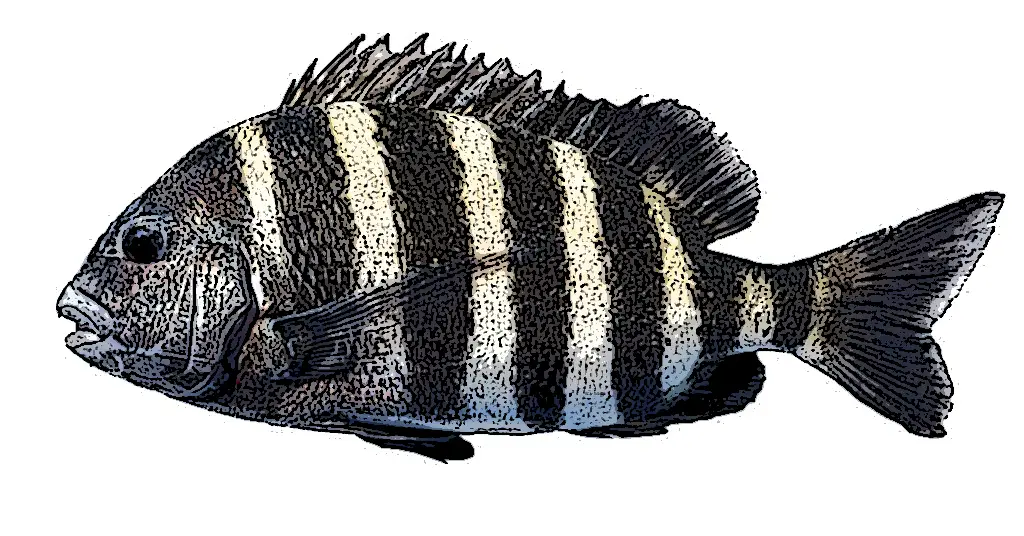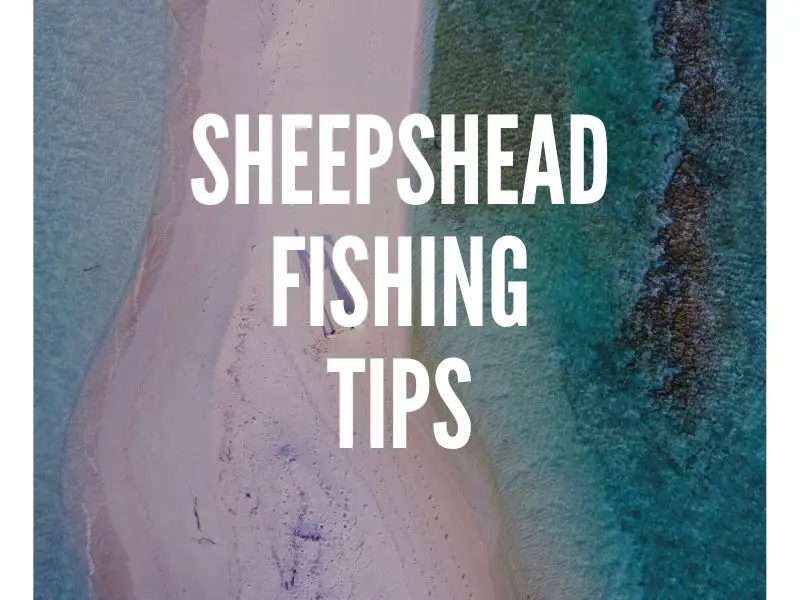Sheepsheads Fish, also known as the convict fish due to it’s black and white bars, are a popular game fish to catch along the Western Atlantic Ocean. They look very similar to black drum and are often confused with this species. Though they don’t look particularly pleasing, they are known to be quite delicious, which is another reason they are popular to catch among anglers.
If you’re fishing for sheepshead we created this guide for you. Here we will cover how to identify sheepshead, where to catch them, their seasonal patterns, the best equipment to catch them and offer some additional tips to help you catch them.
What Does a Sheepshead Fish Look Like?
Sheepshead are a flat fish that are often white or light gray in color with five to six dark-colored bars down the side if it’s body. They also have sharp dorsal fins. They look very similar to black drum and are often confused with them, but they can be easily identified by their teeth. Sheepshead have protruding teeth that look like human teeth.

Sheepshead on average weight between about 2-5 pounds, though some have been known to reach sizes up to 15lbs. The world record sheepshead is a 16 pound 6-ounce fish that was caught in South Carolina.
Where To Catch Sheepshead
Sheepshead are saltwater fish that are common throughout the Western Atlantic Ocean. In the United States, it is common to catch them From North Carolina, South Carolina and all the way down to Florida.
If you’re looking for sheepshead they can be found inshore, in coastal creeks, rivers, bays, and lagoons. Where you are most likely to catch them really depends on the season.
They tend to migrate offshore around structure and reefs in the summer. Nearshore around structure like rocks in the winter, and inshore around docks, piers, and other structures during the spring and fall.
What Do Sheepshead Eat?
Sheepshead are known to mostly forage crustaceans. Their diet mostly consists of barnacles, shellfish, mussels, oysters, and crab. If you find an area that has a lot of these, it is probably a good place to fish for sheepshead.
Sheepshead Seasonal Patterns
Fall
Sheepshead tend to be very active in the fall as they prepare for winter spawning. This makes it a great opportunity to catch them. You can commonly find them in the grassy flats looking for crabs, or around inshore piers and seawalls. They like to feed and crabs, barnacles, and oysters, so if you find an abundance of these, there are sure to be some sheepshead lurking nearby.
Winter
In the winter sheepshead tend to head offshore for spawning. Some will stay behind close to shore though, which you can find near piers are reefs. This is also where you will find sheepshead before and after the spawning. The good thing about fishing sheepshead in the winter is not a lot of other fish stay in the area, so if you are targeting sheepshead specifically, you don’t need to worry about other fish stealing your bait. Try using fresh clams, oysters, mussels, or barnacles for bait.
Spring
As sheepshead return from their winter spawn they tend to be closer to shore where you can find them near heavy rocks, jetties, piers, and reefs. They always tend to stay near structure and can be targeted relatively easily close to shore.
Summer
In the summer months sheepshead change up their feeding habits a bit. They usually follow a high tide into grassy flats looking for crab. Crab is a good bait option in the summer months. Look for shallow grassy areas where the sheepshead may be hunting for crab.
Cast your crab about 4-5 feet outside the strike zone and gently reel it into the area you think the sheepshead are at. If you place your bait directly on top of the fish, this will spook them. You need to make it appear like it naturally drifts into the water.
Fishing Equipment for Sheepshead
Rods and Reels
Spinning rods and reels are the most common when fishing for sheepshead. Generally, a medium spinning rod around 7 feet in length with fast or extra fast action is ideal. These will work fine in most scenarios.
If you’re an advanced angler and you’re going to be fishing tall piers or around deep water, you may want a baitcasting reel for fishing sheepshead. If you’re going to be using a baitcasting reel something right around 7 feet in length with fast action is a good option.
In some areas you can also use a fly rod for fishing sheepshead. This is not as common and is only ideal in certain situations. This can be a good option if you’re fishing shallow grassy flats or inshore sandbars. If you’re using a fly reel an 8 to 10 weight fast action fly rod would be ideal. For saltwater fishing, it is always best to use a weight-forward fly line.
Lures and Bait
Soft Lures
Not very many artificial lures work that well for fishing sheepshead. The ones that do work are lures that imitate what sheepshead regularly eat. Use a small soft lure that imitates what the sheepshead are feeding on in the area such as a crab or shrimp lure. Sheepshead have a small mouth so you have to use a small lure or the fish won’t bite.
Fiddler Crabs or Other Crabs
Crabs such as fiddler crabs are usually the most effective bait choice when it comes to fishing sheepshead. You can catch your own crabs to hook or use frozen crabs (though live tend to work best).
Barnacles
You can also use a small chunk of barnacles to fish for sheepshead. Some anglers also like to chum an area up by scraping barnacles off of structure to get the sheepshead into a frenzy.
Small Chunks of Oyster and Clams
Sheepshead have small mouths so make sure if you are using oysters and clams that you are using small biteable chunks. You have to ensure that your hook is exposed. If you can’t see the point of your hook, your piece is too big.
Shrimp
Lastly, shrimp is another good option depending on the area you are fishing. You can use live or dead. Again just make sure you are not using too large of a shrimp.
Fishing Line
Most common for fishing sheepshead is a braided line because it gives a good amount of sensitivity for the light bite of a sheepshead. Usually between a 10lb to 20lb test line is ideal for these fish. You will definitely want to choose a fishing line that has a good amount of sensitivity when fishing for sheepshead.
Hooks
Sheepshead are known for having strong jaws and small mouths. So you need a hook small enough to fit in their mouth, but strong enough that it won’t be broken. A size 1/0 circle hook is a good size for a sheepshead, just make sure the brand you choose is strong enough for the job.
Tips for Catching Sheepshead
Pay Attention to Your Rig
Sheepshead are known to have a very light bite, which is why having sensitive equipment is important when fishing for them. Pay attention to gentle taps and make sure to check your rig often with small movements, as you may have a biting sheepshead and not be aware of it.
Use Small Baits and Lures
As we’ve stated earlier, you have to use small baits and lures if you’re going to catch sheepshead. They have small mouths and will not attack your presentation if it’s too large. Just remember that when fishing for them. Don’t be afraid to use small chunks of bait to make your rig more enticing to them.
Chum Up The Area You are Fishing
Sheepshead can smell food from a long way away. This is why chumming is a great tactic to get the sheepshead into a feeding frenzy. When fishing nearshore reefs and rocks try scrape off barnacles or oysters or toss small bits into the water. This can get the sheepshead riled up and create a good environment to get them biting.
Fish Tidal Movements
Try fishing for sheepshead about an hour or two before or after a tide ebbs or peaks. They tend to bite more often during this time, likely due to the fact that their food is most available to them in those conditions.
Related Posts:
Snook Fishing Tips
Rockfish Fishing Tips
How to Catch Ribbonfish
